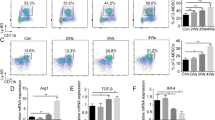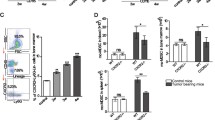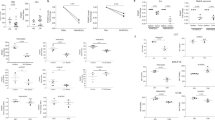Abstract
Accumulation of myeloid-derived suppressor cells (MDSCs) is one of the major obstacles against achieving appropriate anti-tumor immune responses and successful tumor immunotherapy. Granulocytic MDSCs (G-MDSCs) are common in tumor-bearing hosts. However, the mechanisms regulating the development of MDSCs, especially G-MDSCs, remain poorly understood. In this report, we showed that interferon regulatory factor 7 (IRF7) plays an important role in the development of G-MDSCs, but not monocytic MDSCs. IRF7 deficiency caused significant elevation of G-MDSCs, and therefore enhanced tumor growth and metastasis in mice. IRF7 deletion did not affect the suppressive activity of G-MDSCs. Mechanistic studies showed that S100A9, a negative regulator of myeloid cell differentiation, was transrepressed by the IRF7 protein. S100A9 knockdown almost completely abrogated the effects of IRF7 deletion on G-MDSC development and tumor metastasis. Importantly, IRF7 expression levels negatively correlated with the G-MDSC frequency and tumor metastasis, as well as S100A9 expression, in cancer patients. In summary, our study demonstrated that IRF7 represents a novel regulator of G-MDSC development in cancer, which may have predictive value for tumor progression.
This is a preview of subscription content, access via your institution
Access options
Subscribe to this journal
Receive 50 print issues and online access
$259.00 per year
only $5.18 per issue
Buy this article
- Purchase on Springer Link
- Instant access to full article PDF
Prices may be subject to local taxes which are calculated during checkout







Similar content being viewed by others
References
Gabrilovich DI, Nagaraj S . Myeloid-derived suppressor cells as regulators of the immune system. Nat Rev Immunol 2009; 9: 162–174.
Marigo I, Dolcetti L, Serafini P, Zanovello P, Bronte V . Tumor-induced tolerance and immune suppression by myeloid derived suppressor cells. Immunol Rev 2008; 222: 162–179.
Marvel D, Gabrilovich DI . Myeloid-derived suppressor cells in the tumor microenvironment: expect the unexpected. J Clin Invest 2015; 125: 3356–3364.
Condamine T, Mastio J, Gabrilovich DI . Transcriptional regulation of myeloid-derived suppressor cells. J Leukoc Biol 2015; 98: 913–922.
Waight JD, Netherby C, Hensen ML, Miller A, Hu Q, Liu S et al. Myeloid-derived suppressor cell development is regulated by a STAT/IRF-8 axis. J Clin Invest 2013; 123: 4464–4478.
Vasquez-Dunddel D, Pan F, Zeng Q, Gorbounov M, Albesiano E, Fu J et al. STAT3 regulates arginase-I in myeloid-derived suppressor cells from cancer patients. J Clin Invest 2013; 123: 1580–1589.
Capietto AH, Kim S, Sanford DE, Linehan DC, Hikida M, Kumosaki T et al. Down-regulation of PLCgamma2-beta-catenin pathway promotes activation and expansion of myeloid-derived suppressor cells in cancer. J Exp Med 2013; 210: 2257–2271.
Marigo I, Bosio E, Solito S, Mesa C, Fernandez A, Dolcetti L et al. Tumor-induced tolerance and immune suppression depend on the C/EBPbeta transcription factor. Immunity 2010; 32: 790–802.
Noman MZ, Desantis G, Janji B, Hasmim M, Karray S, Dessen P et al. PD-L1 is a novel direct target of HIF-1alpha, and its blockade under hypoxia enhanced MDSC-mediated T cell activation. J Exp Med 2014; 211: 781–790.
Condamine T, Kumar V, Ramachandran IR, Youn JI, Celis E, Finnberg N et al. Hockstein N, Witt R, Masters G, Bauer T, Gabrilovich DI. ER stress regulates myeloid-derived suppressor cell fate through TRAIL-R-mediated apoptosis. J Clin Invest 2014; 124: 2626–2639.
Thevenot PT, Sierra RA, Raber PL, Al-Khami AA, Trillo-Tinoco J, Zarreii P et al. The stress-response sensor chop regulates the function and accumulation of myeloid-derived suppressor cells in tumors. Immunity 2014; 41: 389–401.
Youn JI, Nagaraj S, Collazo M, Gabrilovich DI . Subsets of myeloid-derived suppressor cells in tumor-bearing mice. J Immunol 2008; 181: 5791–5802.
Solito S, Marigo I, Pinton L, Damuzzo V, Mandruzzato S, Bronte V . Myeloid-derived suppressor cell heterogeneity in human cancers. Ann N Y Acad Sci 2014; 1319: 47–65.
Peranzoni E, Zilio S, Marigo I, Dolcetti L, Zanovello P, Mandruzzato S et al. Myeloid-derived suppressor cell heterogeneity and subset definition. Curr Opin Immunol 2010; 22: 238–244.
Gabrilovich DI, Ostrand-Rosenberg S, Bronte V . Coordinated regulation of myeloid cells by tumours. Nat Rev Immunol 2012; 12: 253–268.
Ning S, Pagano JS, Barber GN . IRF7: activation, regulation, modification and function. Genes Immun 2011; 12: 399–414.
Honda K, Yanai H, Negishi H, Asagiri M, Sato M, Mizutani T et al. IRF-7 is the master regulator of type-I interferon-dependent immune responses. Nature 2005; 434: 772–777.
Kim JK, Jin X, Ham SW, Lee SY, Seo S, Kim SC et al. IRF7 promotes glioma cell invasion by inhibiting AGO2 expression. Tumour Biol 2015; 36: 5561–5569.
Zhang L, Zhang J, Lambert Q, Der CJ, Del Valle L, Miklossy J et al. Interferon regulatory factor 7 is associated with Epstein-Barr virus-transformed central nervous system lymphoma and has oncogenic properties. J Virol 2004; 78: 12987–12995.
Bidwell BN, Slaney CY, Withana NP, Forster S, Cao Y, Loi S et al. Silencing of Irf7 pathways in breast cancer cells promotes bone metastasis through immune escape. Nat Med 2012; 18: 1224–1231.
Romieu-Mourez R, Solis M, Nardin A, Goubau D, Baron-Bodo V, Lin R et al. Distinct roles for IFN regulatory factor (IRF)-3 and IRF-7 in the activation of antitumor properties of human macrophages. Cancer Res 2006; 66: 10576–10585.
Yu LX, Yan L, Yang W, Wu FQ, Ling Y, Chen SZ et al. Platelets promote tumour metastasis via interaction between TLR4 and tumour cell-released high-mobility group box1 protein. Nat Commun 2014; 52: 5256.
Mauti LA, Le Bitoux MA, Baumer K, Stehle JC, Golshayan D, Provero P et al. Myeloid-derived suppressor cells are implicated in regulating permissiveness for tumor metastasis during mouse gestation. J Clin Invest 2011; 121: 2794–2807.
Condamine T, Ramachandran I, Youn JI, Gabrilovich DI . Regulation of tumor metastasis by myeloid-derived suppressor cells. Annu Rev Med 2015; 66: 97–110.
Yang L, DeBusk LM, Fukuda K, Fingleton B, Green-Jarvis B, Shyr Y et al. Expansion of myeloid immune suppressor Gr+CD11b+ cells in tumor-bearing host directly promotes tumor angiogenesis. Cancer Cell 2004; 6: 4094–21.
Cheng P, Corzo CA, Luetteke N, Yu B, Nagaraj S, Bui MM et al. Inhibition of dendritic cell differentiation and accumulation of myeloid-derived suppressor cells in cancer is regulated by S100A9 protein. J Exp Med 2008; 205: 2235–2249.
Sinha P, Okoro C, Foell D, Freeze HH, Ostrand-Rosenberg S, Srikrishna. G . Proinflammatory S100 proteins regulate the accumulation of myeloid-derived suppressor cells. J Immunol 2008; 181: 4666–4675.
Hibino T, Sakaguchi M, Miyamoto S, Yamamoto M, Motoyama A, Hosoi J et al. S100A9 is a novel ligand of EMMPRIN that promotes melanoma metastasis. Cancer Res 2013; 73: 172–183.
Ichikawa M, Williams R, Wang L, Vogl T, Srikrishna G . S100A8/A9 activate key genes and pathways in colon tumor progression. Mol Cancer Res 2011; 9: 133–148.
Talmadge JE, Gabrilovich DI . History of myeloid-derived suppressor cells. Nat Rev Cancer 2013; 13: 739–752.
Qin A, Cai W, Pan T, Wu K, Yang Q, Wang N et al. Expansion of monocytic myeloid-derived suppressor cells dampens T cell function in HIV-1-seropositive individuals. J Virol 2013; 87: 1477–1490.
Huang A, Zhang B, Wang B, Zhang F, Fan KX, Guo YJ . Increased CD14(+)HLA-DR (-/low) myeloid-derived suppressor cells correlate with extrathoracic metastasis and poor response to chemotherapy in non-small cell lung cancer patients. Cancer Immunol Immunother 2013; 62: 1439–1451.
Kalathil S, Lugade AA, Miller A, Iyer R, Thanavala Y . Higher frequencies of GARP(+)CTLA-4(+)Foxp3(+) T regulatory cells and myeloid-derived suppressor cells in hepatocellular carcinoma patients are associated with impaired T-cell functionality. Cancer Res 2013; 73: 2435–2444.
Lu R, Pitha PM . Monocyte differentiation to macrophage requires interferon regulatory factor 7. J Biol Chem 2001; 276: 45491–45496.
Foell D, Wittkowski H, Vogl T, Roth J . S100 proteins expressed in phagocytes: a novel group of damage-associated molecular pattern molecules. J Leukoc Biol 2007; 81: 28–37.
Clark HL, Jhingran A, Sun Y, Vareechon C, de Jesus CS, Skaar EP et al. Zinc and manganese chelation by neutrophil S100A8/A9 (calprotectin) limits extracellular aspergillus fumigatus hyphal growth and corneal infection. J Immunol 2016; 196: 336–344.
Chernov AV, Dolkas J, Hoang K, Angert M, Srikrishna G, Vogl T et al. The calcium-binding proteins S100A8 and S100A9 initiate the early inflammatory program in injured peripheral nerves. J Biol Chem 2015; 290: 11771–11784.
Wang L, Chang EW, Wong SC, Ong SM, Chong DQ, Ling KL . Increased myeloid-derived suppressor cells in gastric cancer correlate with cancer stage and plasma S100A8/A9 proinflammatory proteins. J Immunol 2013; 190: 794–804.
Acharyya S, Oskarsson T, Vanharanta S, Malladi S, Kim J, Morris PG et al. A CXCL1 paracrine network links cancer chemoresistance and metastasis. Cell 2012; 150: 165–178.
McNeill E, Hogg N . S100A9 has a protective role in inflammation-induced skin carcinogenesis. Int J Cancer 2014; 135: 798–808.
Shojaei F, Wu X, Zhong C, Yu L, Liang XH, Yao J et al. Bv8 regulates myeloid-cell-dependent tumour angiogenesis. Nature 2007; 450: 825–831.
Gabrilovich DI, Chen HL, Girgis KR, Cunningham HT, Meny GM, Nadaf S et al. Production of vascular endothelial growth factor by human tumors inhibits the functional maturation of dendritic cells. Nat Med 1996; 2: 1096–1103.
Damuzzo V, Pinton L, Desantis G, Solito S, Marigo I, Bronte V et al. Complexity and challenges in defining myeloid-derived suppressor cells. Cytometry B Clin Cytom 2015; 88: 77–91.
Yang Q, Shi M, Shen Y, Cao Y, Zuo S, Zuo C et al. COX-1-derived thromboxane A2 plays an essential role in early B-cell development via regulation of JAK/STAT5 signaling in mouse. Blood 2014; 124: 1610–1621.
Yang Q, Wei J, Zhong L, Shi M, Zhou P, Zuo S et al. Cross talk between histone deacetylase 4 and STAT6 in the transcriptional regulation of arginase 1 during mouse dendritic cell differentiation. Mol Cell Biol 2015; 35: 63–75.
Acknowledgements
This work was supported by the following grants to JZ: National Natural Science Foundation of China (No. 81571520; 91542112; and 31270921), Guangdong Province Universities and Colleges Pearl River Scholar Funded Scheme (GDUPS, 2014), National Key Basic Research Program of China (No. 2012CB524900), Guangdong Innovative Research Team Program (No. 2009010058), The Fundamental Research Funds for the Central Universities, the Provincial Talents Cultivated by ‘Thousand-Hundred-Ten’ program of Guangdong Province, 111 Project (No. B12003).
Author information
Authors and Affiliations
Corresponding author
Ethics declarations
Competing interests
The authors declare no conflict of interest.
Additional information
Supplementary Information accompanies this paper on the Oncogene website .
Supplementary information
Rights and permissions
About this article
Cite this article
Yang, Q., Li, X., Chen, H. et al. IRF7 regulates the development of granulocytic myeloid-derived suppressor cells through S100A9 transrepression in cancer. Oncogene 36, 2969–2980 (2017). https://doi.org/10.1038/onc.2016.448
Received:
Revised:
Accepted:
Published:
Issue Date:
DOI: https://doi.org/10.1038/onc.2016.448
This article is cited by
-
Neuropilin-1high monocytes protect against neonatal inflammation
Cellular & Molecular Immunology (2024)
-
Loss of IRF7 accelerates acute myeloid leukemia progression and induces VCAM1-VLA-4 mediated intracerebral invasion
Oncogene (2022)
-
Dexamethasone and lactoferrin induced PMN-MDSCs relieved inflammatory adverse events of anti-cancer therapy without tumor promotion
Communications Biology (2021)
-
Prognostic Biomarker-Based Identification of Drugs for Managing the Treatment of Endometrial Cancer
Molecular Diagnosis & Therapy (2021)
-
Lactoferrin deficiency induces a pro-metastatic tumor microenvironment through recruiting myeloid-derived suppressor cells in mice
Oncogene (2020)



